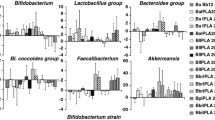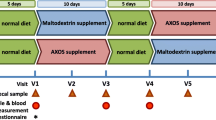Abstract
Gut Bifidobacterium microbiota of the elderly has been suggested to differ from that of adults, possibly promoting the risk of infections and gut barrier dysfunction. Specific probiotics may improve the gut barrier. In this randomized, placebo-controlled intervention study, 66 elders consumed a fermented oat drink containing probiotic Bifidobacterium longum 46 and B. longum 2C or a non-fermented placebo oat drink for 6 months. Faecal samples were collected before, during and after the intervention. Levels of faecal bifidobacteria were determined using species-specific quantitative PCR and plate counting. The Bifidobacterium levels in the elderly were high and the species composition diverse. Probiotic intervention increased the levels bifidobacteria significantly. Specifically, the levels of B. catenulatum, B. bifidum and B. breve were enhanced. Consumption of the fermented oat drink itself was also associated with certain changes in microbiota. In conclusion, Bifidobacterium microbiota of elderly subjects may be modulated by probiotic administration. In some healthy elderly populations, Bifidobacterium microbiota may be more abundant and diverse than previously suggested.
Similar content being viewed by others
References
Altschul SF, Madden TL, Schaffer AA et al (1997) Gapped BLAST and PSI-BLAST: a new generation of protein database search programs. Nucleic Acids Res 25:3389–3402. doi:10.1093/nar/25.17.3389
Bartosch S, Fite A, Macfarlane GT et al (2004) Characterization of bacterial communities in feces from healthy elderly volunteers and hospitalized elderly patients by using real-time PCR and effects of antibiotic treatment on the fecal microbiota. Appl Environ Microbiol 70:3575–3581. doi:10.1128/AEM.70.6.3575-3581.2004
Bartosch S, Woodmansey EJ, Paterson JC et al (2005) Microbiological effects of consuming a synbiotic containing Bifidobacterium bifidum, Bifidobacterium lactis, and oligofructose in elderly persons, determined by real-time polymerase chain reaction and counting of viable bacteria. Clin Infect Dis 40:28–37. doi:10.1086/426027
Collado MC, Meriluoto J, Salminen S (2007) Role of commercial probiotic strains against human pathogen adhesion to intestinal mucus. Lett Appl Microbiol 45:454–460. doi:10.1111/j.1472-765X.2007.02212.x
Collado MC, Meriluoto J, Salminen S (2008) Adhesion and aggregation properties of probiotic and pathogen strains. Eur Food Res Technol 226:1065–1073. doi:10.1007/s00217-007-0632-x
Gavini F, Cayuela C, Antoine JM et al (2001) Differences in the distribution of bifidobacterial and enterococcal species in human faecal microflora of three different (children, adults, elderly) age groups. Microb Ecol Health Dis 13:40–45. doi:10.1080/089106001750071690
Gueimonde M, Delgado S, Baltasar M et al (2004) Viability and diversity of probiotic Lactobacillus and Bifidobacterium populations included in commercial fermented milks. Food Res Int 37:839–850
Gueimonde M, Debor L, Tölkkö S et al (2007) Quantitative assessment of faecal bifidobacterial populations by real-time PCR using lanthanide probes. J Appl Microbiol 102:1116–1122
Halttunen T, Salminen S, Tahvonen R (2007) Rapid removal of lead and cadmium from water by specific lactic acid bacteria. Int J Food Microbiol 114:30–35. doi:10.1016/j.ijfoodmicro.2006.10.040
He T, Harmsen HJ, Raangs GC et al (2003) Composition of faecal microbiota of elderly people. Microb Ecol Health Dis 15:153–159. doi:10.1080/08910600310020505
Hopkins MJ, Sharp R, Macfarlane GT (2001) Age and disease related changes in intestinal bacterial populations assessed by cell culture, 16S rRNA abundance, and community cellular fatty acid profiles. Gut 48:198–205. doi:10.1136/gut.48.2.198
Hütt P, Shchepetova J, Loivukene K et al (2006) Antagonistic activity of probiotic lactobacilli and bifidobacteria against entero- and uropathogens. J Appl Microbiol 100:1324–1332. doi:10.1111/j.1365-2672.2006.02857.x
Lahtinen SJ, Gueimonde M, Ouwehand A et al (2006) Comparison of four methods to enumerate probiotic bifidobacteria in a fermented food product. Food Microbiol 23:571–577. doi:10.1016/j.fm.2005.09.001
Lahtinen SJ, Jalonen L, Ouwehand AC et al (2007) Specific Bifidobacterium strains isolated from elderly subjects inhibit growth of Staphylococcus aureus. Int J Food Microbiol 117:125–128. doi:10.1016/j.ijfoodmicro.2007.02.023
Langendijk PS, Schut F, Jansen GJ et al (1995) Quantitative fluorescence in situ hybridization of Bifidobacterium spp. with genus-specific 16S rRNA-targeted probes and its application in fecal samples. Appl Environ Microbiol 61:3069–3075
Leahy SC, Higgins DG, Fitzgerald GF et al (2005) Getting better with bifidobacteria. J Appl Microbiol 98:1303–1315. doi:10.1111/j.1365-2672.2005.02600.x
Mäkeläinen H, Tahvonen R, Salminen S et al (2003) In vivo safety assessment of two Bifidobacterium longum strains. Microbiol Immunol 47:911–914
Mälkki Y, Virtanen E (2001) Gastrointestinal effects of oat bran and oat gum. Lebensm-Wiss u-Technol 34:337–347
Matsuki T, Watanabe K, Tanaka R et al (1999) Distribution of bifidobacterial species in human intestinal microflora examined with 16S rRNA-gene-targeted species-specific primers. Appl Environ Microbiol 65:4506–4512
Mitsuoka T, Hayakawa K (1972) Die Faecalflora bei Menschen I. Mitteilung: Die Zusammensetzung der Faecalflora der verschiedenen Altersgruppen. Zbl Bakt Hyg I Abt Orig A 223:333–342
Mitsuoka T, Hayakawa K, Kimura N (1974) Die Faecalflora bei Menschen II. Mitteilung: Die Zusammensetzung der Bifidobakterienflora der verschiedenen Altersgruppen. Zbl Bakt Hyg I Abt Orig A 226:469–478
Mutai M, Tanaka R (1987) Ecology of Bifidobacterium in the human intestinal flora. Bifidobact Microflora 6:33–41
Nordic Council of Ministers (2004) Nordic nutrition recommendations 2004. Integrating nutrition and physical activity, 4th edn. Nordic Council of Ministers, Copenhagen
Nybom SM, Salminen SJ, Meriluoto JA (2007) Removal of microcystin-LR by strains of metabolically active probiotic bacteria. FEMS Microbiol Lett 270:27–33. doi:10.1111/j.1574-6968.2007.00644.x
Ouwehand AC, Salminen S, Isolauri E (2002) Probiotics: an overview of beneficial effects. Ant Van Leeuw 82:279–289. doi:10.1023/A:1020620607611
Ouwehand AC, Bergsma N, Parhiala R et al (2008a) Bifidobacterium microbiota and parameters of immune function in elderly subjects. FEMS Immunol Med Microbiol 53:18–25. doi:10.1111/j.1574-695X.2008.00392.x
Ouwehand AC, Tiihonen K, Saarinen M et al (2008b) Influence of a combination of Lactobacillus acidophilus NCFM and lactitol on healthy elderly: intestinal and immune parameters. Br J Nutr. doi:10.1017/S00007114508003097
Pitkälä KH, Strandberg TE, Finne-Soveri UH et al (2007) Fermented cereal with specific bifidobacteria normalizes bowel movements in elderly nursing home residents. A randomized, controlled trial. J Nutr Health Aging 11:305–311
Rinne MM, Gueimonde M, Kalliomäki M et al (2005) Similar bifidogenic effects of prebiotic-supplemented partially hydrolyzed infant formula and breastfeeding on infant gut microbiota. FEMS Immunol Med Microbiol 43:59–65. doi:10.1016/j.femsim.2004.07.005
Sakata S, Kitahara M, Sakamoto M et al (2002) Unification of Bifidobacterium infantis and Bifidobacterium suis as Bifidobacterium longum. Int J Syst Evol Microbiol 52:1945–1951. doi:10.1099/ijs.0.02221-0
Salminen S, Ouwehand A, Salminen E et al (2002) Method for screening probiotic strains of the genus Bifidobacterium. World Patent WO 02/38798
Silvi S, Verdenelli MC, Orpianesi C et al (2003) EU project Crownalife; functional foods, gut microflora and healthy aging. Isolation and identification of Lactobacillus and Bifidobacterium strains from faecal samples of elderly subjects for a possible probiotic use in functional foods. J Food Eng 56:195–200. doi:10.1016/S0260-8774(02)00249-2
Woodmansey EJ, McMurdo ME, Macfarlane GT et al (2004) Comparison of compositions and metabolic activities of fecal microbiotas in young adults and in antibiotic-treated and non-antibiotic-treated elderly subjects. Appl Environ Microbiol 70:6113–6122. doi:10.1128/AEM.70.10.6113-6122.2004
Acknowledgements
Bioferme (Kaarina, Finland) is thanked for providing the test oat products used in the study. Dr. Miguel Gueimonde is thanked for helpful discussions. Sampo Lahtinen was funded by the ABS Graduate School.
Author information
Authors and Affiliations
Corresponding author
About this article
Cite this article
Lahtinen, S.J., Tammela, L., Korpela, J. et al. Probiotics modulate the Bifidobacterium microbiota of elderly nursing home residents. AGE 31, 59–66 (2009). https://doi.org/10.1007/s11357-008-9081-0
Received:
Accepted:
Published:
Issue Date:
DOI: https://doi.org/10.1007/s11357-008-9081-0




